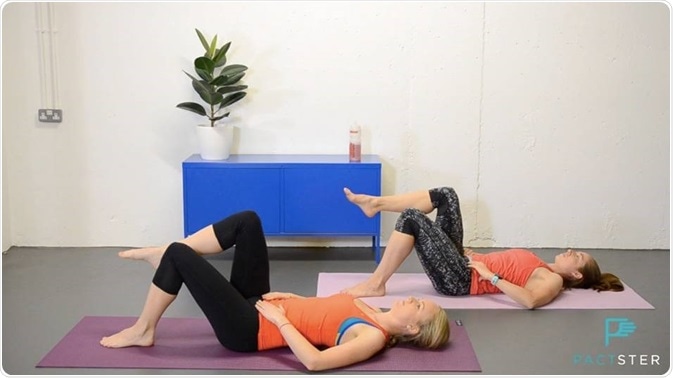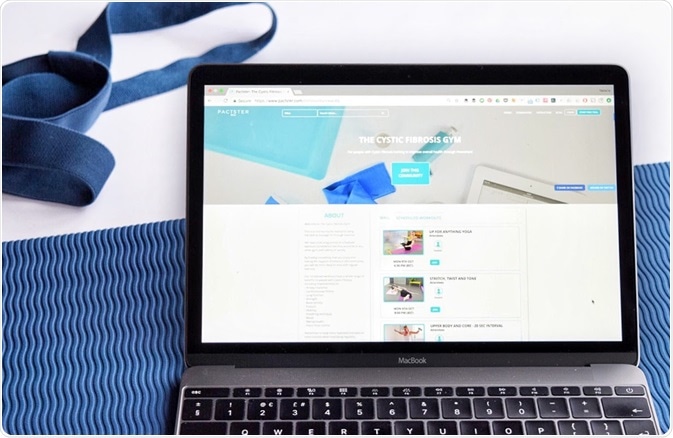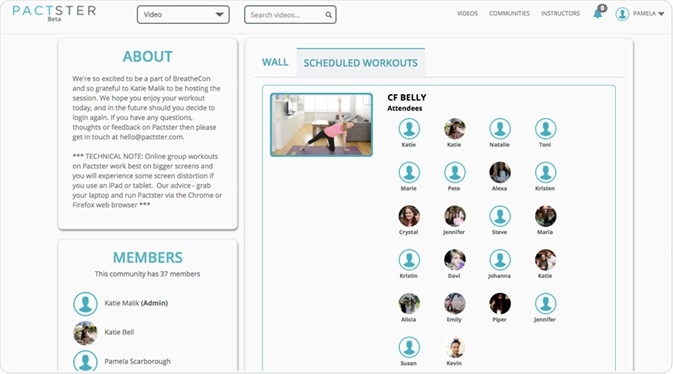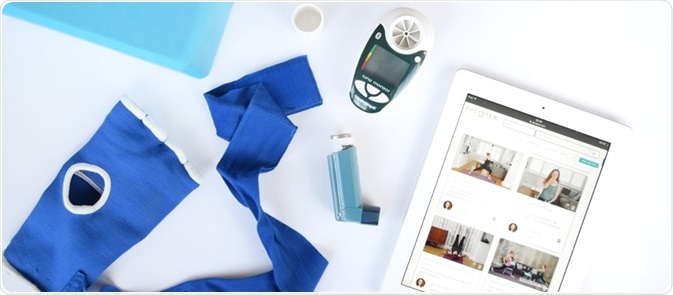An interview with Pamela Scarborough, conducted by James Ives, MPsych
Please give an overview of the role of exercise in cystic fibrosis (CF)
We know that exercise is beneficial in helping someone to maintain their lung function, stay strong and active and maintain a good quality of life. We also know that exercise can complement ‘airway clearance techniques’ – breathing exercises prescribed by physiotherapists to help clear the lungs of mucus.

As well as benefitting lung function, exercise can help to address other complications of CF such as low bone mineral density, CF-related diabetes, low back pain, postural problems and stress incontinence.
Then, there are many other wonderful benefits such as improved mood and sleep, which is important for someone with a life-limiting condition.
Without exercise, what other methods are used to help CF patients clear the mucous that builds up in their lungs?
As physios, we use a wide range of approaches. The traditional methods that people associate with CF physio are postural drainage, percussion and active cycle breathing techniques − deep breathing exercises to open up the airways of the lungs in order to get behind sputum and get it moving so that it can be cleared with a huff or a cough.
However, we are increasingly using other techniques, for example, oscillatory devices such as a flutter or an acapella; positive expiratory pressure devices such as the Pari PEP; or different breathing exercises such as autogenic drainage. There is also a high-frequency chest wall oscillating vest, which is like a life jacket that vibrates. The aim of all physio techniques is to open up the airways, loosen the mucus, and make it easier to clear.
How important do you think physiotherapy is for people with CF? How prevalent is exercise therapy in CF treatment?
Physio is a cornerstone of CF care and has always been recognized as having a very important role to play. Even from point of diagnosis, when a child may be asymptomatic with their chest, their parents are still taught to engage them in exercise and to get them moving around to make sure they're maximizing ventilation of the lungs and helping to move any sputum that's there.
The wide-ranging benefits of exercise on health are continuing to emerge. Throughout my professional career, I have seen people who have come from active families and the fitter they were when they were younger, the better outcome they have later down the line; they're still functioning at a higher level because they had that training in their younger years.
People are seeing exercise as another way to help control their health, and it is also something that's more normal to do and that they can do socially with their peers. Someone with CF often has a huge amount of treatment to undertake, a lot of which can be unpleasant, so exercise can be preferable as it is something that can be enjoyable. Every time we see a patient, we ask them about what they are managing to do from an exercise point of view.
What are the main differences between workouts that are specifically designed for CF patients, as opposed to just standard workout routines?
We don't know exactly how exercise programmes for someone with CF should vary from the normal population; we still need more research to prove this – so what we're saying is that people with CF should be doing the same amount of cardiovascular exercise and strength and conditioning training as recommended in the national guidelines for the healthy population.
However, because of the factors I mentioned before − that people with CF are very likely to suffer from postural problems, low back pain, stress incontinence and low bone mineral density, etc − physios prescribe exercise programs that make sure we’re addressing these issues before they become a problem, or if they are a problem, that the need is met.
Why is it important to have a personalized exercise routine and what range of exercise routines are available on Pactster?
It is important to have a personalized exercise regime because we are all different; we all have different interests and we all have different needs. There is a lot of pressure on people with CF to exercise for health benefits, so we must find a way to make it enjoyable and effective for them. We need to have exercise that is engaging and does not just feel like treatment. It needs to feel like it is going to be fun, as well as meeting the patient’s needs and be easy to integrate into a daily routine.
With a lot of the workouts we have on Pactster, we have really tried to normalize exercise. We know that exercise is medicine, but we want it to be something fun and normal that everybody does. We have used physios and people with CF who are qualified fitness instructors as instructors in the videos; but we film the videos out of the hospital setting, in normal clothes and cover popular exercise disciplines such as yoga, mixed martial arts, pilates, circuits and high-intensity interval training. We are creating more videos to cater for people of different ages and interests, and throughout different stages of the disease.
We are hoping that Pactster will overcome the usual barriers that put people off exercising, like lack of time and money, but that it will also make exercise easier for people who may struggle with low mood, find it hard to get out of the house because they are dependent on oxygen or equipment, have a compromised immune system or who may be too self-conscious to go to the gym. Some people with CF find group classes embarrassing because people may turn and look at them if they start coughing.
Pactster has been designed to overcome these barriers, so that people can gain confidence exercising in their home environments and be reassured that they're exercising in a safe way, supported by someone who understands their condition.

Zelda and Leah, two CF physios from The Royal Brompton and Harefield NHS Trust
Please give an overview of Pactster and the unique features that you bring to CF physiotherapy?
Pactster offers health-specific exercise videos filmed with specialist instructors alongside community and motivational support. Our exercise videos have been filmed with CF physiotherapists and people with CF who are qualified instructors; and have been approved by the Association of Chartered Physiotherapists in Cystic Fibrosis.
We want people to be inspired by seeing someone with the same condition as them on screen, sharing their knowledge of how to use exercise to take control of their disease.

Currently, in the videos we have on Pactster, the CF instructors are quite highly functioning, but we're creating new videos that will include people with more advanced disease and people who are pre- or post-transplant, as well as families and kids. Even with more advanced disease, there are still so many fitness role models with CF who who are phenomenal in what they achieve given the challenges that they face, and who have so much knowledge to share.
Pactster gives the opportunity for people with CF to workout alone or with others in a group setting, this is an important feature as people with CF are unable to meet one another face-to-face due to a risk of cross infection which can significantly impact life expectancy.
These group workouts can be facilitated by a person with CF or by a physio. The good thing about this is that it provides an opportunity for peer support, or if a physio is running the session it may have prevent the need for a hospital visit.
Group workouts are also about motivating and inspiring others as well as providing accountability, enjoyment, and the opportunity for learning. We are currently developing the behaviour change features on Pactster to make it easier to stick to an exercise regime.

Group, online workout has an unlimited number of people who are able to attend
Are there any limitations to the workouts? Do they need specific equipment? I'm guessing these are all open access to all CF patients?
In the UK, our arrangement with the Cystic Fibrosis Trust means that all people with CF, as well as their caregivers and physios can have free access to Pactster. Due to the way CF care is delivered in the UK, it is expected that anyone with CF coming onto the platform would have already been seen by a specialist in a CF centre and that they would have had conversations with their physio about the right amount and type of exercise necessary, as well as how to exercise safely.

It is expected that people come to the platform with some understanding of exercise and then they can participate in what they feel is right for them. Maybe they'll try something they haven't tried before because it's been put right in front of them and it's easy to do.
Access is free and the equipment that you need to use may vary from one exercise discipline to another. Some will require more hand weights, but you can improvise with a book or a can, for example. There's also a kettle bell workout on there, if that's what people are interested in. Generally, most of the exercises require an exercise mat, but not very much equipment after that.
Is it also open access to patients outside of the UK?
There is a monthly subscription of five pounds per month if you're outside of the UK, but our aim is to try and make it free. As a British person, I believe in the NHS and I believe it is wonderful that healthcare can be free at the point of access.
I would love to make Pactster free for anyone who needs it because we want to reduce as many barriers as possible for someone exercising. Although it's not much of a financial barrier, making payments is still a barrier for some people. We've got people who have signed up from other places around the world, but people are already asking whether there is going to be a similar arrangement in Germany, South Africa, or America and I'd like to find a way to make sure that we can make it free for them.
Will you expand the exercise routines and physiotherapy for other conditions in the future or are you focusing primarily on CF?
I'm predominately a CF physio by background and coincidentally, one of my best friends has CF, so I have a very strong personal attachment to creating this for people with CF and I want to see it working, being a huge success and making a difference.
I do feel that being able to offer specialized exercise videos to someone in their home is incredibly important, as well as being able to provide remote physio support and to connect people who are going through similar conditions. Once we are happy that we have CF working as well as we want it to from a behavior change point of view, as well as videos covering all stages of life from point of diagnosis through to end of life, then yes, we are looking to provide the same service in collaboration with other hospitals or charities for other health conditions.
One example, which we think would be our next step would be working with people with breast cancer as we know exercise is a very important therapeutic intervention for people with breast cancer. Also, at different points of life from diagnosis, pre-mastectomy, post-mastectomy, chemo and radiotherapy, there are lots of barriers to exercise and lots of reasons that exercise needs to be tailored at different points for different needs. The breast cancer population would be another example of a population that we'd like to support using Pactster.
What would you like to see as the future of physiotherapy treatment for CF patients, both in the UK and globally?
I would like physio to be as easily integrated into someone's life as it can possibly be and every treatment to be as effective as possible. I believe that is about personalizing care and looking at different ways to support people in different settings − at home, in hospital and in the community. I also believe it’s about tailoring our treatment and making it the best we can through creating more of an evidence base and not being afraid to progress with things. Physio is a difficult, laborious task for someone with CF and if we can make it as streamlined, personalized and effective as possible, then that would be awesome.
Ideally, I don't want people to have to do physio. I want there to be a cure for CF, but so long as that is not the case, then let's make the therapy the best we possibly can. I'm excited to see where things go from a digital health point of view, because I think there's potentially lots of different things we can do.
About Pamela Scarborough
Pamela has been a phyiotherapist in the NHS for 15 years, predominantly working with people with cystic fibrosis. Pamela completed a Master’s looking at yoga for thoracic kyphosis and lower back pain in CF, as well as studying adherence and behaviour change in greater detail. Here, she most enjoyed researching and presenting in those areas, as well as teaching others, sharing new information and approaches on adherence and yoga within the community.
Since then Pamela has been working on Pactster, where she enjoys the creativity of a start-up environment and is excited about the potential of digital health in improving quality and delivery of care. She finds it incredibly satisfying to see people using Pactster and finding it beneficial.